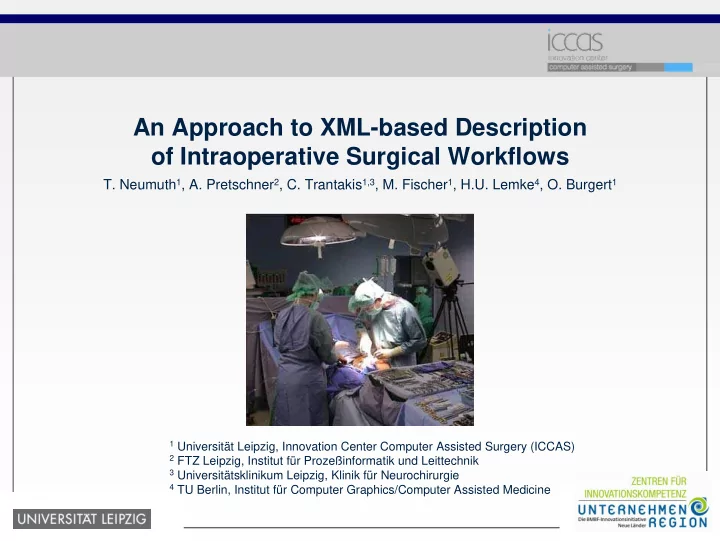

An Approach to XML-based Description of Intraoperative Surgical Workflows T. Neumuth 1 , A. Pretschner 2 , C. Trantakis 1,3 , M. Fischer 1 , H.U. Lemke 4 , O. Burgert 1 1 Universität Leipzig, Innovation Center Computer Assisted Surgery (ICCAS) 2 FTZ Leipzig, Institut für Prozeßinformatik und Leittechnik 3 Universitätsklinikum Leipzig, Klinik für Neurochirurgie 4 TU Berlin, Institut für Computer Graphics/Computer Assisted Medicine
Contents • Introduction • Challenges • Concepts • Instruments • Transformations to SVG • Clinical Use • Conclusions and the look ahead • Standardization
Vision of ICCAS • Computer Assisted Surgery in the past: – Technology driven – Limitation to special cases – No interoperability – Replacement of the surgeon • Vision of ICCAS: – Research based on scientific process analysis – High medical relevance of all solutions – Integration and interoperability – Assistance of the surgeon
Surgical Workflows and OR-Workflows W. Sandberg et al: Setting a Research Agenda for Perioperative Systems Design
Description of Surgical Interventions: Medical Challenges (Examples) • How often is instrument of type “cutting” used? • At which anatomical structures has it been used? • What is the viewing direction of the surgeon? • Are there ergonomic limitations? • How much time do one gain/spend using technique X? • What is the “typical” procedure for intervention Y? • How to evaluate the use of mechatronical ressources?
Description of Surgical Interventions: Technical Challenges Recording of Workflows • Large amount of information to be recorded: – Active body parts (both hands, view, … of all participants) – Parallel and overlapping actions – High level of detail (every single work item!) • Missing tracking technology • Lack of surgical ontology Workflow Processing • Visualization of Workflows • Aggregation of single workflows to condensed workflows • Analysis of Workflows • Identification of Surgical Integration Profiles (SIPs)
Concepts XSD Editor Web Accessible Stand Alone Core Editor Version Editor Version •Recording Ontology Database •Processing Workflow •Storing Database Transformationen Visualization Reporting other Use Cases
Reasons for XML •Usage as Meta-Language •„Human readability“ •Complex structures •Independence of representation •Openess •Simplified development of transformations •Transferability and knowledge management
Workflow recording scheme (simplified) Recording solution
Screenshot of the workflow-editor Workflow-Editor
Representation for clinical users insert retractor musculus Preparation N done Phase Y PraPML insert drainage Prozeßablaufplan Markup Language in situ N done Main Y Operation operational remove retractor Phase ex situ N done Insert retractor Y suture drainage Closing cutis Phase N N done done Y Y suture needle Condition in situ N done Y connect drainage ex situ N done Y
SVG-Representation • Generation of graphical positions for task visualisation • Presentment of – Participants with active parts – Causal and temporal relations between tasks – Starttime, Stoptime, duration of a task – Used instruments, executed activities, treated anatomic structures – Mixed representation of temporal and logical structures � Inferences: � High complexity � Aggregation of logical structure � Generation of graphical information from time-related information
Detailed problems • Frame sizes rect _ y _ padd / 2 i=6 x x x x x x rect x padd _ _ / 2 ECMAScript ECMAScript SVG/ECMAScript … … … var height = new Number(amount_lines * sign_height + function getMaxChars(…) <xsl:element name="svg:g"> rect_y_padd + line_space * (amount_lines - 1)) … … … <xsl:attribute name="onload">draw_operation(…)"/>', … • Arrow directions SVG …d=“M105 100 L170 80 L210 190“… suture ECMAScript drainage …function getAngle(170,80,210,190)… cutis SVG …arr_group.setAttribute(…rotate(…)…)…
Workflow processing • To visualize a single surgical intervention • To viualize and to compare surgical interventions of the same type • To compare intervention types of a discipline • To compare related intervention types between different disciplines • To identify Surgical Integration Profiles (SIP) • To define Clinical-Good-Practice-Workflows (CGP-WF) Intervention 1 Intervention 2 surgeon assistant surgeon assistant left right left right left right left right 00:00:00 A E A C C F B F 00:00:10 D B D
Conclusions and the look ahead • Clinical documentation • Intervention planning and evaluation • Knowledge extraction and formalizing of surgical know-how • Instrument for comparison of surgical schools and quality assurance • Ergonomic improvement • Derivation and evluation of surgical assitance systems • Automation of the OR and workflow systems development
Standardization • NEMA Diagnostic Imaging and Therapy Systems Division • DICOM Working Group 24 – Surgical DICOM • Workflow analysis • Workflow support systems – Initial meeting 06/2004 NEMA National Electrical Manufacturers Association DICOM Digital Imaging and Communications in Medicine
Acknowledgement The “Innovation Center Computer Assisted Surgery” is funded by • the Federal Ministry of Education and Research (BMBF) and • the Saxon Ministry of Science and the Fine Arts (SMWK) Grant No. “03 ZIK 031” and “03 ZIK 032” Centers of Innovation Competence “Unternehmen Region”
Thank you for your attention! Thomas Neumuth Research Fellow University of Leipzig Innovation Center Computer Assisted Surgery Working Group „Scientific Methods“ Tel.: +49-341-97-12000 thomas.neumuth@medizin.uni-leipzig.de
Recommend
More recommend